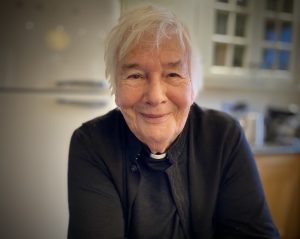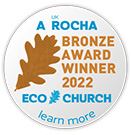Time to shout about our Cornish Celtic Quiet Places

Visitors pour into Cornwall for the coastline, countryside, big skies and surf. But how many of them know about our rich Celtic heritage? Or our beautiful Cornish Celtic Quiet Places quietly nestling across our county, waiting patiently to envelope and embrace them?
Some of these places of quiet contemplation have been enriching our lives for the best part of two millennia. Revd Canon Pat Robson thinks they’re a secret ready for sharing. “I realised many years ago that despite there being over 300 Cornish Celtic Churches, not to mention the towns and villages named after Celtic saints, Cornwall did little to promote or celebrate its Celtic presence in the world. If you want to have any kind of intentional Celtic experience, you have to go all the way to Lindisfarne or Iona.”
“Despite there being over 300 Cornish Celtic Churches… Cornwall did little to promote or celebrate its Celtic presence in the world. If you want to have any kind of intentional Celtic experience, you have to go all the way to Lindisfarne or Iona.”
How a church became a Cornish Celtic Quiet Place that hugged a troubled man
It was a very particular encounter one summer in St Just church, Gorran Haven, that convinced Pat that it was time to release the soothing balm of the Cornish Celtic churches to a wider public. “A man walked into this tiny church looking very troubled. He’d left his young family on the beach and was very anxious. He told me he was in debt and couldn’t really afford to bring his family on holiday. He hadn’t told his wife. I asked if there was anything I could do and he said no, ‘Just let the church hug me.’”
It says it all. These churches were founded by ancient saints, searching out quiet places to be alone with God. Over hundreds and hundreds of years they have become steeped in love and prayer, and long to offer that ‘hug’ to everyone seeking sanctuary.
From Morwenstowe to Zennor and St Levan, there will be quiet sanctuary for anyone who needs it.
Pat isn’t a ‘someone should do that’ sort of person. She’s more ‘let’s see how we can make that happen’. Making the Cornish Celtic Quiet Places happen has meant visiting over 70 small churches. Pat has heard or shared with them their Celtic ancestry and brought them together to form a network that laces its way across Cornwall. As she says, “From Morwenstowe to Zennor and St Levan, there will be quiet sanctuary for anyone who needs it.
“Many of these places are tiny and were worried they might have to close, or only open for special days and festivals. But by joining together as Cornish Celtic Quiet Places, we can support one another and not only offer something unique to Cornwall that celebrates our Celtic heritage, but keeps the doors open all year round. All that is required of each church is that they are open at the times they say they will be and are welcoming to all comers.”
“By joining together as Cornish Celtic Quiet Places, we can support one another and offer something unique to Cornwall that celebrates our Celtic heritage.”
Website for Cornish Celtic Quiet Places in Spring, 2023
In March 2023 Pat will be launching an official website that gives full details of every church signed up to be a Cornish Celtic Quiet Place, including whether they have loos, car parks or which field to cross or gate to open to find them. After that time, other Celtic churches will be invited to join in. “It will be marvellous. People will be able to buy a pilgrim passport, like on the Cornish Celtic Way, have it stamped every time they visit one of the churches, and help to reveal and revive these hidden gems of quiet contemplation.”
Bishop Philip is also thrilled. “I’m so grateful to Pat for all her work on this inspiring project. The fact so many churches have signed up to take part is testament to the effort Pat has put in and the enduring power and significance of the holy, special places our parish churches are. I encourage churches to get involved and I look forward to hearing many great stories as the project progresses.”
How did it all begin?
So how did this network of small churches become so woven into the tapestry of Cornish Celtic history? And how did it all begin?
Pat explains, “The Celtic Saints were mostly young, Romanised British Celts who fled west when the Angles and Saxons invaded. Taught by teachers influenced by St Martin of Tours, they understood the imperative to give up their riches, go into the world and seek out a quiet, desert place. There they could be alone with Christ and get to know Him as a soul friend. And this is what they brought with them when they arrived in Cornwall, which is why the Celtic churches are often in isolated locations.”
Villages and towns have since developed around many of these original sites. Bodmin for example used to be a forest, and it was here that Goran first settled by a spring. But he was visited by his friend St Petroc, from Padstow way, who was a renowned teacher with a big following. He sought some quiet time with his friend and in the morning asked if he could share Goran’s quiet space. Goran refused knowing St Petroc’s followers would seek him out and disrupt the peace. Instead, he gave the special place to his friend and moved on to the coast to find a new sanctuary, settling very near to a boyhood friend, St Just who had a small oratory overlooking the sea.
Martyrdom and the heritage of our Cornish flag
Even our Cornish flag has its origins in the Celtic saints. Before going out into the world, saints would choose a martyrdom particular to them. Some chose white martyrdom, symbolised by the white cross, leaving their homes and families not knowing if they would ever see them again. They became priests and evangelists and many settled in Cornwall, Devon and Brittany.
Others, typically the eldest and heirs, would choose the red martyrdom, a red cross on white. They would become soldiers and protectors. St Kea was originally a red martyr, fighting for King Arthur. But he switched to become a white martyr, came to Cornwall and founded a monastery.
There was also the green martyrdom. These saints wanted to become hermits and live in quiet isolation to pray for the world. St Austol was a green martyr and travelled with his friend St Mewan, who wanted to be an evangelist and white martyr. They first made their home in woods that became the town St Austell, then travelled together to Brittany. There they had a great ministry as evangelist and adviser. When Mewan died, Austol was heartbroken and died seven days later. When they opened the tomb to bury him alongside his friend, they found Mewan had moved over to make space for him.
A cautionary tale about a bishop
There are a great many stories like this around the Celtic Saints and Pat is in the process of gathering them to include in the new website. It’s so important that they are shared as the cautionary tale Bishop Bronscombe’s exploits reveal. If, on his pilgrimages into Cornwall, he arrived at a church with a name he didn’t recognise, and there was no story to explain it, he would change its name to a saint he did know.
How the love of the Celtic saints endures to touch our lives today
Having met Pat, I’m pretty sure the Cornish Celtic Quiet Places will become an important movement in the future history of Cornwall. She has an incredible wealth of stories but also a passion to share the values of those young saints who sacrificed so much to come to Cornwall. They trod lightly on the earth, they loved God’s creation and sought out quiet time to be with Christ, to share His love and bring about incredible change. It has endured to touch the life of a debt burdened young man desperate to provide a family holiday, seeking a hug from a quiet church, tucked in a narrow street, on the way from the carpark to the beach.
Pat is an inspiring woman who holds the notion of sanctuary for everyone deep in her soul. She has many more stories to tell, and not just about ancient Celtic saints. She has had a lifetime of adventures, including a dedication to helping Romanian disabled orphans back in the brutal days of Nicolae Ceaușescu. But that’s an article for another day.
If you’re keen to hear more about how Cornish Celtic saints had such an impact on our heritage, Pat’s book, “Heretics, Hermits, Bishops and Kings” is available from the Cathedral Bookshop or directly from Pat





